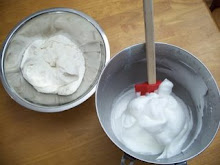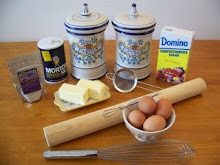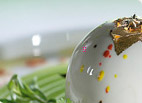Since its inauguration in 1989, I've dreamed of attending the Coupe du Monde de la Patisserie in Lyon, France. And even though I have yet to make it, I still follow it every two years when the best pastry chefs in the world gather to compete for the most prestigious pastry challenge in the world, what we English speakers call the Pastry World Cup.
The 2011 Coupe du Monde, sponsored by Chocolat Valrhona, wrapped up at the end of January. Spain took the gold, Italy the silver (woo hoo), and Belgium took the bronze. The US did win first place for its sugar showpiece, and the ever dominant team France didn't compete this year. All gold medal winners are prohibited from participating in the following competition (France won in 2009).
 |
| Spain's winning showpiece. Photo courtesy of Chocolat Valrhona. |
 |
| USA's sugar showpiece. Photo courtesy of Chocolat Valrhona. |
Since I didn't make it again this year (sigh), I decided to do the next best thing, interview the captain from the only US team to ever win gold in Lyon.
At the 2001 Pastry World Cup, captain Ewald Notter and his team mates En-Ming Hsu and Michel Willaume made history, bringing home the first and only gold medal for team USA. Ewald Notter, author of the newly released book The Art of The Chocolatier, master of chocolate and sugar art, and founder of the Notter School of Pastry Arts in Orlando, Florida, was a well seasoned competitor by the time he was selected for team USA.
Having won 15 gold medals at various pastry competitions across the globe before moving to America in 1992, he took up the US pastry competition scene and won gold two consecutive years at the World Pastry Team Championships in Beaver Creek, Colorado. By the time he made team USA for the Coupe du Monde, he was ready to retire from the competition circuit.
 | |||||
| Ewald Notter creating a sugar showpiece at his Notter School of Pastry Arts | . |
When I asked Notter if he was nervous despite his formidable competition record, he replied, "Oh my god I was very nervous. I knew it would be my last competition and there was a lot of pressure too, we wanted to make a good job. And we took risks, if you want to win you always have to take risks. I don't think you win if you don't take risks. You want to be better, everything should be a step up."
Notter and his team only had six months to prepare, unlike many teams who have up to a year and a half to prepare. But in Notter's mind, this wasn't a disadvantage.
"We all had the right motivation and the right mood. It was very intense but having only six months is sometimes better than having a year or a year and a half to prepare. You have to get it done so you concentrate and you start and you pull it through. It worked for us very well."
All competitions are stressful, just watch an episode of Food Network Challenge and you'll see. But the Pastry World Cup is hands down the biggest challenge of all. It's prestige brings with it a lot of press, and a lot of stress. And it's no exception to the general rule that if things can go wrong, they will go wrong. But rising to the challenges that crop up during a competition sets the winners apart from the losers.
2001 was no exception for Notter and his team.
"Oh we had our challenges on that day. The ice wasn't standing well, my sugar piece broke, and in the morning we had no power. A lot of things happened, but in any competition things happen and I think you can only prepare so much. But if your team worked and trained together a lot of times, well every time you train together things happen, and so it's never a total disaster if anything breaks on the day of the competition because you're used to fixing things. You're used to working together and helping each other."
 |
| Notter's sugar showpiece for Team USA in 2001. |
All of Notter's competition experience over the years helped him a lot when it came to the Pastry World Cup. As he explained to me, to his mind, when things go wrong or showpieces break, it can be an opportunity instead of a setback.
"I tell you, in any competition I did, always something broke. I honestly believe that because something broke and the judges can see how you can fix it again and you don't lose your mind, you just put your head down and redo it and put it up, this can be impressive too. You have to learn to work with what you have. It's what I like to teach my students as well, if something breaks you find another way to arrange it and find a way to still put something up. It's the only way if you want to be successful."
Winning the 2001 Pastry World Cup was a fitting end to such a long and prestigious competition career. Today Notter focuses on teaching at the Notter School of Pastry Arts, where he offers both a six month pastry arts course for beginners as well as continuing education for professionals. And when he's not teaching, he's traveling the globe doing demonstrations, coaching competitors, and acting as a guest instructor at other schools.
"There's a time to compete and a time to help other people to compete. I did a lot of competitions before I came to America and then did it all again. I made a lot of friends and learned a lot, so it was time to give back."
Though not competing himself, Notter still goes to Lyon to watch the Coup du Monde de la Patisserie, where he has often coached members of other teams. Here's hoping I see him there myself in 2013!
Special thanks the the sponsor of the Coupe du Monde de la Patisserie, Chocolat Valhrona, for the photos from this year's competition.


















